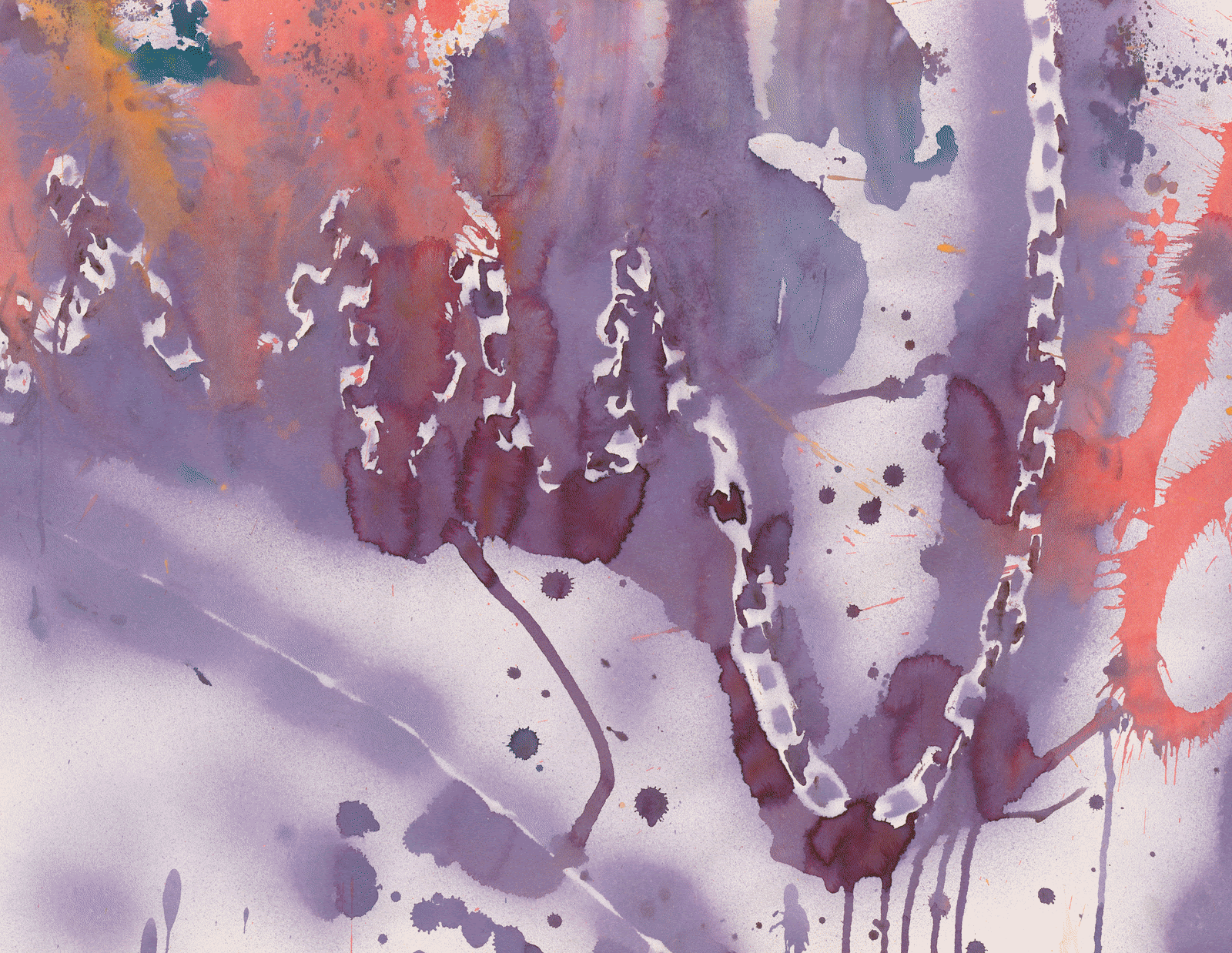Alexander Gray Associates, New York presents Melvin Edwards: Lines for the Poet, the artist’s seventh one-person exhibition with the Gallery. It marks the debut of a series of never-before-shown ca. 1974 watercolors, as well as Lines for the Poet, a previously unrealized 1970 barbed wire installation. Together, these “new” historic works shed light into a pivotal moment in Edwards’s artistic development as he began to articulate alternative understandings of color, materiality, and space.
Edwards’s reconceptions were deeply informed by the work of his friends, fellow Black abstractionists like Sam Gilliam and Frank Bowling. Like Gilliam and Bowling, he questioned established approaches to composition and form. Isolating discarded lengths of barbed wire and chain, he flicked, sprayed, and brushed watercolor over them. The resulting drawings with their luminous grounds and gestural drips recall both the hazy, layered washes of pigment in Gilliam’s Beveled-EdgePaintings (1967–73) and the wild rivulets of acrylic in Bowling’s Poured Paintings (1973–78).
Foregrounding unfettered chromatic expression, Edwards’s technique results in compositions that are simultaneously joyous and foreboding; the barbaric nature of their imagery—tools of subjugation and incarceration—undercut by their vivid color. This destabilizing disjunction speaks to the artist’s interest in imbuing “straight” formalism with meaning. “I have always understood the brutalist connotations inherent in materials like barbed wire,” he reflected in 1973. “… [A]nd my creative thoughts have always anticipated the beauty of utilizing that necessary complexity which arises from the use of these materials in what could be called a straight … style.”
Similarly, Lines for the Poet (1970/2023) harnesses barbed wire’s “necessary complexity” to challenge viewers’ perceptions of space and free movement. Edwards developed the concept for this work in advance of his 1970 one-person exhibition of barbed wire installations at the Whitney Museum of American Art, the institution’s first single-artist show of work by an African American sculptor. Titled in homage to the poet Jayne Cortez (1934–2012), the artist’s late wife and a central figure of the Black Arts Movement, Lines for the Poet consists of stanza-like planes of barbed wire that extend up and outwards from a steel beam. The installation is in conversation with Gilliam’s immersive Drape paintings from the same period. Like Gilliam’s site-responsive canvases, which fold and unfurl from the ceiling, Edwards’s suspended wire verses redefine the architecture of their site.
At the same time, much like Edwards’s watercolors, Lines for the Poet alludes to the intertwined histories of American agriculture, slavery, and violence. In tandem, these works bring to the fore the complex narratives embedded in utilitarian materials—narratives that relate to both contemporary sociopolitical concerns and the artist’s own biography. As Edwards concludes, “Using barbed wire, you have to be aware that it was a way to keep the cows at home. But then people turned it into concentration camps. … Those contradictions, or contradistinctions are things that have occupied me in visual art. As a way to realize the dynamic in a situation, art or otherwise, they’re very important to me.”
Retrospectives of Edwards’s work have been presented at Nasher Sculpture Center, Dallas, TX (2015), traveled to Zimmerli Museum of Art, Rutgers University, New Brunswick, NJ (2015), and to Columbus Museum of Art, OH (2016), and Neuberger Museum of Art, State University of New York at Purchase (1993), traveled to The Art Museum at Florida International University, Miami (1994), Hood Museum of Art, Dartmouth College, Hanover, NH (1994), and to McNay Art Museum, San Antonio, TX (1995). Edwards’s sculptures are currently on view at deCordova Sculpture Park and Museum, Lincoln, MA and Dia Beacon, NY. His work has been the subject of recent one-person exhibitions at City Hall Park, Public Art Fund, New York, NY (2021); Ogden Museum of Southern Art, New Orleans, LA (2020); Baltimore Museum of Art, MD (2019); and Museu de Arte de São Paulo, Brazil (2018), among others. He has also participated in numerous group exhibitions, including New York: 1962–1964, The Jewish Museum, New York, NY (2022); The Dirty South: Contemporary Art, Material Culture, and the Sonic Impulse, Virginia Museum of Fine Arts, Richmond (2021), traveled to Contemporary Arts Museum Houston, TX (2021); Soul of a Nation: Art in the Age of Black Power, Tate Modern, London, United Kingdom (2017), traveled to Crystal Bridges Museum of American Art, Bentonville, AK (2018), Brooklyn Museum, NY (2018), The Broad, Los Angeles, CA (2019), de Young Museum, Fine Arts Museums of San Francisco, CA (2019), and The Museum of Fine Arts, Houston, TX (2020); Postwar: Art Between the Pacific and the Atlantic 1945–1965, Haus der Kunst, Munich, Germany (2016); 56th Venice Biennale: All the World’s Futures, Italy (2015); Witness: Art and Civil Rights in the Sixties, Brooklyn Museum, NY (2014); traveled to Hood Museum of Art, Dartmouth College, Hanover, NH (2014); and Blanton Museum of Art, University of Texas at Austin (2015); and Blues for Smoke, The Geffen Contemporary at The Museum of Contemporary Art, Los Angeles, CA (2012), traveled to Whitney Museum of American Art, New York, NY (2013), and Wexner Center for the Arts, Columbus, OH (2013). Edwards’s work is represented in the collections of the Brooklyn Museum, NY; Buffalo AKG Art Museum, NY; The Cleveland Museum of Art, OH; Dia Art Foundation, NY; Los Angeles County Museum of Art, CA; The Metropolitan Museum of Art, New York, NY; The Museum of Fine Arts, Houston, TX; The Museum of Modern Art, New York, NY; National Gallery of Art, Washington, DC; Pennsylvania Academy of the Fine Arts, Philadelphia; San Francisco Museum of Modern Art, CA; The Studio Museum in Harlem, New York, NY; and Whitney Museum of American Art, New York, NY, among others. Edwards taught at Rutgers University, The State University of New Jersey, from 1972 to 2002. In 2014, he received an honorary doctorate from the Massachusetts College of Art and Design, Boston. The artist is also represented by Stephen Friedman Gallery, London, United Kingdom.
Alexander Gray Associates
510 W 26th St, New York, NY 10001, United States
